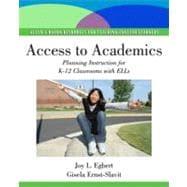
Note: Supplemental materials are not guaranteed with Rental or Used book purchases.
Purchase Benefits
What is included with this book?
Joy Egbert, PhD, is Professor of ESL and Education Technology at Washington State University, Pullman. She is an award winning teacher, materials developer, and researcher. She is the author of Supporting Learning with Technology: Essentials of Classroom Practice (Pearson, 2009), CALL Essentials (TESOL, Inc, 2005), and seven other books for ESL and technology-using teachers, in addition to many other publications.
Dr. Gisela Ernst-Slavit is a professor at Washington State University Vancouver. She investigates language and education in culturally and linguistically diverse settings using ethnographic and sociolinguistic perspectives. She teaches courses in ESL methods, sociolinguistics, research on second language teaching and learning, and critical issues for Latino students.
PART ONE – Understanding the Roles of Language and Content
Chapter 1 – Academic success: Learning the language of school
Chapter 2 – The role of language proficiency in school
PART TWO – Components of Effective Lesson Design
Chapter 3 – Assessing student strengths and needs
Chapter 4 – Writing and teaching to language objectives
Chapter 5 – Connecting to students’ lives
Chapter 6 –Designing Engaging Tasks
Chapter 7 – Assessing Lessons and Students
PART THREE – Designing Lessons for Academic Success
Chapter 8 – Unlocking the language of Ssience
o Emphasis on inquiry and discovery learning
o Vocabulary
o Grammar/Syntax
o Discourse
o Language functions
· Teaching strategies for learning and talking science
· Talking science: An example from the classroom
o For Reflection
o For Action
Chapter 9 – Unlocking the language of mathematics
o Emphasis on problem solving
o Vocabulary
o Grammar/Syntax
o Discourse
o Language functions
· Teaching strategies for learning and talking mathematics
· Talking math: An example from the classroom
o For Reflection
o For Action
Chapter 10 – Unlocking the language of English language arts
o Preparing students for the literacy demands of today and tomorrow
o Texts
o Processes and strategies
o Systems of structure of language
o Audiences
o Contexts
· Teaching strategies for learning language skills and literacies
· Placing the learner at the center: An example from the classroom
o For Reflection
o For Action
Chapter 11 – Unlocking the language of social studies
· Key Issues
· About the field of social studies
· The specialized language of social studies
o Grammatical features
o Discourse
· Strategies for teaching and learning social studies
· Extensions
o For Reflection
o For Action
Chapter 12--Putting it all together
· Key Issues
· Background
· Understanding the whole
· Lesson examples
o Adapting lessons
· Guidelines for creating and adapting lessons
· Extensions
o For Reflection
o For Action
References
Appendix A
Index (to be decided)
The New copy of this book will include any supplemental materials advertised. Please check the title of the book to determine if it should include any access cards, study guides, lab manuals, CDs, etc.
The Used, Rental and eBook copies of this book are not guaranteed to include any supplemental materials. Typically, only the book itself is included. This is true even if the title states it includes any access cards, study guides, lab manuals, CDs, etc.